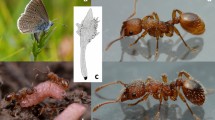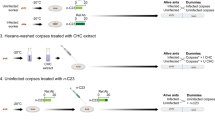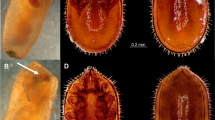Abstract
Social animals like ants, although seemingly well-armed against parasites because of the protective nature of the social system, are nevertheless exposed to several parasitic organisms, among them fungi of the order Laboulbeniales (Ascomycetes). Rickia wasmannii is one such ectoparasitic fungus that lives on different species of the ant genus Myrmica in Europe. The fungus attaches to the outer layer of the cuticle, while appearing on the surface of the hosts as a setae-like structure. There is little information on the effects of the fungi on the host. Usually it is regarded as neutral, in spite of its high abundance on the ants. We studied the impact of a R. wasmannii infection on the lifespan and grooming behavior of its main host M. scabrinodis in artificial nests in laboratory conditions for 2 months. The lifespan of infected individuals was significantly reduced in comparison with the lifespan of uninfected ants. The frequency of allogrooming was significantly higher in infected nests, while only a marginally significant positive effect could be detected in the case of autogrooming. Increased grooming may either be an effective aspect of host defense or, alternatively, a pathogen-induced behavioral change that enhances pathogen transmission. This study thus provides the first documented evidence of the potential effects of R. wasmannii on its ant hosts.


Similar content being viewed by others
References
Bates D., Maechler M., Bolker B. and Walker S. 2014. lme4 package. Linear mixed-effects models using Eigen and S4. retrieved from http://lme4.r-forge.r-project.org/, published online on 02.02.2014
Bhatkar A. and Whitcomb W.H. 1970. Artificial diet for rearing various species of ants. Fla. Entomol. 55: 229-232
Bezděčka P. and Bezděčková K. 2011. First record of the myrmecophilous fungus Rickia wasmannii (Ascomycetes: Laboulbeniales) in Slovakia. Folia faunistica 16: 71-72
Büchler R., Drescher W. and Tornier I. 1992. Grooming behaviour of Apis cerana, Apis mellifera and Apis dorsata and its effect on the parasitic mites Varroa jacobsoni and Tropilaelaps clareae. Exp. Appl. Acarol. 16: 313-319
Csata E., Czekes Zs., Erős K., Német E., Hughes M., Csősz S. and Markó B. 2013. Comprehensive survey of Romanian myrmecoparasitic fungi: new species, biology and distribution. North-West. J. Zool. 9: 23-29
Csősz S. and Majoros G. 2009. Ontogenic origin of mermithogenic Myrmica phenotypes (Hymenoptera, Formicidae). Insect. Soc. 56: 70-76
Csősz S., Lapeva-Gjonova A. and Markó B. 2012. New data on the geographical distribution and host utilization of entomopathogenic fungus Myrmicinosporidium durum. J. Insect Sci. 12: 1-5
Czekes Zs., Radchenko A.G., Csősz S., Szász-Len A.-M., Tăuşan I., Benedek K. and Markó B. 2012. The genus Myrmica Latreille, 1804 (Hymenoptera: Formicidae) in Romania: distribution of species and key for their identification. Entomol. Romanica 17: 29-50
Espadaler X. and Santamaria S. 2012. Ecto- and endoparasitic fungi on ants from the Holarctic region. Psyche 168478
Evans H.C., Elliot S.L. and Hughes D.P. 2011. Ophiocordyceps unilateralis. A keystone species for unraveling ecosystem functioning and biodiversity of fungi in tropical forests? Commun. Integr. Biol. 4: 598-602
Fernández-Marín H., Zimmerman J.K., Rehner S.A. and Wcislo W.T. 2006. Active use of the metapleural glands by ants in controlling fungal infection. Proc. R. Soc. Biol. Sci. 273: 1689-1695
García F., Espadaler X., Echave P. and Vila R. 2010. Hormigas (Hymenoptera, Formicidae) de los acantilados de l’Avenc de Tavertet (Barcelona, Península Ibérica). Boletín de la S.E.A. 47: 363-367
Gemeno C., Zurek L. and Schal C. 2004. Control of Herpomyces spp. (Ascomycetes: Laboulbeniales) infection in the wood cockroach, Parcoblatta lata (Dictyoptera: Blattodea: Blattellidae), with benomyl. J. Invertebr. Pathol. 85: 132-135
Haelewaters D. 2012. The first record of Laboulbeniales (Fungi, Ascomycota) on Ants (Hymenoptera, Formicidae) in The Netherlands. Ascomycete org. 4: 65-69
Haelewaters D., van Wielink P., van Zuijlen J.W., Verbeken A. and de Kesel A. 2013. New records of Laboulbeniales (Fungi, Ascomycota) for the Netherlands. Entomol. Ber. 72: 175-183
Kaur S. and Mukerji K.G. 2006. The Laboulbeniales (Ascomycetes): distribution and host parasite relationships. In: Current Concepts in Botany (Mukerji K.G. and Manoharachary C., Eds). I.K. International, New Delhi, India, pp 19-35
Konrad M., Vyleta M.L., Theis F.J., Stock M., Tragust S., Klatt M., Drescher V., Marr C., Ugelvig L.V. and Cremer S. 2012. Social transfer of pathogenic fungus promotes active immunisation in ant colonies. Plos. Biol. 10: e1001300
Lapeva-Gjonova A. and Santamaria S. 2011. First records of Laboulbeniales (Acomycota) on ants (Hymenoptera: Formicidae) in Bulgaria. ZooNotes 22: 1-6
Manga-González M.Y., González-Lanza C., Cabanas E. and Campo R. 2001. Contributions to and review of dicrocoeliosis, with special reference to the intermediate hosts of Dicrocoelium dendriticum. Parasitology 123: S91-S114
Nalepa A.C. and Weir A. 2007. Infection of Harmonia axyridis (Coleoptera: Coccinellidae) by Hesperomyces virescens (Ascomycetes: Laboulbeniales): Role of mating status and aggregation behavior. J. Invertebr. Pathol. 94: 196-203
Oi D.H. and Pereira R.M. 1993. Ant behavior and microbial pathogens (Hymenoptera: Formicidae). Fla. Entomol. 76: 63-74
Okuno M., Tsuji K., Sato H. and Fujisaki K. 2012. Plasticity of grooming behaviour against entomopathogenic fungus Metarhizium anisopliae in the ant Lasius japonicus. J. Ethol. 30: 23-27
Ortiz-Urquiza A. and Keyhani N.O. 2013. Action on the surface: entomopathogenic fungi versus the insect cuticle. Insects 4: 357-374
Poinar Jr. G. 2012. Nematode parasites and associates of ants: past and present. Psyche e192017, pp 1-13
R Development Core Team. 2011. R: A language and environment for statistical computing. R Foundation for Statistical Computing, Vienna, Austria. ISBN 3-900051-07-0. retrieved from http://www.R-project.org/.
Radchenko A.G. and Elmes G.W. 2010. Myrmica (Hymenoptera: Formicidae) ants of the Old World. Fauna Mundi 3: 1-789
Reber A., Purcell J., Buechel D., Buri P. and Chapuisat M. 2011. The expression and impact of antifungal grooming in ants. J. Evol. Biol. 24: 954-964
Richards G.A. and Smith M.N. 1955. Infection of cockroaches with Herpomyces (Laboulbeniales). I. Life history studies. Biol. Bull. 108: 206-218
Riddick E.W. 2010. Ectoparasitic mite and fungus on an invasive lady beetle: parasite coexistence and influence on host survival. Bull. Insectol. 63: 13-20
Roy H.E., Steinkraus D.C., Eilenberg J., Hajek A.E. and Pell J.K. 2006. Bizarre interactions and endgames: Entomopathogenic fungi and their arthropod hosts. Annu. Rev. Entomol. 51: 331-357
Santamaria S. 2001. Los Laboulbeniales, un grupo enigmático de hongos parásitos de insectos. Lazaroa 22: 3-19
Schmid-Hempel P. 1998. Parasites of Social Insects. Princeton University Press, USA.
Shimizu S. and Yamaji M. 2003. Effect of density of the termite, Reticulitermes speratus Kolbe (Isoptera: Rhinotermitidae), on the susceptibilities to Metarhizium anisopliae. Appl. Entomol. Zool. 38: 125-130
Shoemaker D.D., Ross K.G., Keller L., Vargo E.L. and Werren J.H. 2000. Wolbachia infections in native and introduced populations of fire ants (Solenopsis spp.). Insect. Mol. Biol. 9: 661-673
Shoemaker D.D., Ahrens M., Sheill L., Mescher M., Keller L. and Ross K.G. 2003. Distribution and prevalence of Wolbachia infections in native populations of the fire ant Solenopsis invicta (Hymenoptera: Formicidae). Environ. Entomol. 32: 1329-1336
Strandberg J.O. and Tucker L.C. 1974. Filariomyces forficulae Shanor occurrence and effects on the predatory earwig, Labidura riparia (Pallas). J. Invertebr. Pathol. 24: 357-364
Tartally A., Szőcs B. and Ebsen J.R. 2007. The first records of Rickia wasmannii Cavara, 1899, a myrmecophilous fungus, and its Myrmica Latreille, 1804 host ants in Hungary and Romania (Ascomycetes: Laboulbeniales; Hymenoptera: Formicidae). Myrmecol. News. 10: 123
Tavares I.I. 1979. The Laboulbeniales and their arthropod hosts. In: Insect-Fungus Symbiosis, Nutrition, Mutualism, and Commensalism (Batra L.R., Ed). Allanheld, Osmun & Co., Montclair, pp 229-258
Therneau T. 2012. coxme package. Mixed Effects Cox Models. retrieved from http://r-forge.r-project.org, published online on 15.05.2012.
Vavre F., Fleury F., Varaldi J., Fouillet P. and Bouleatreau M. 2000. Evidence for female mortality in Wolbachia-mediated cytoplasmic incompatibility in haplodiploid insects. Epidemiologic and evolutionary consequences. Evolution 54: 191-200
Watanabe H. 1987. The host population. In: Epizootiology of Insect Diseases (Fuxa J.R. and Tanada Y., Eds). Wiley, New York, pp 71-112
Weir A. and Blackwell M. 2005. Phylogeny of arthropod ectoparasitic ascomycetes. In: Insect-Fungal Associations: Ecology and Evolution (Vega F.E. and Blackwell M., Eds):. Oxford University Press, Oxford, UK, pp 119-145
Weir A. and Beakes G.W. 1996. Correlative light- and scanning electron microscope studies on the developmental morphology of Hesperomyces virescens. Mycologia 88: 677-693
Whisler H.C. 1968. Experimental studies with a new species Stigmatomyces (of Laboulbeniales). Mycologia 60: 65-75
Acknowledgments
We are grateful for the assistance of Zsófia Pálfi, Zsolt Czekes, Enikő Német in the course of our laboratory and field work, and for the help of Monica Hughes regarding the biology of R. wasmannii and, generally, Laboulbeniales fungi. We are also grateful for the suggestions of Lajos Rózsa, Simon Tragust, Timothée Brütsch and Matthias Fürst, which improved the quality of the manuscript considerably. We are also indebted to Thomas Cooper for linguistic revision. Ciprian Mihali kindly provided the SEM photo. During preparation of the manuscript E.Cs. and K.E. were both supported by scholarships of the Collegium Talentum, and also by scholarships in the framework of the TÁMOP-4.2.4.A/2-11/1-2012-0001 “National Excellence Program” offered by the European Union and the State of Hungary and co-financed by the European Social Fund, while B.M. was supported by a grant of the Ministry of National Education (Romania), CNCS-UEFISCDI, project no. PN-II-ID-PCE-2012-4-0595.
Author information
Authors and Affiliations
Corresponding author
Rights and permissions
About this article
Cite this article
Csata, E., Erős, K. & Markó, B. Effects of the ectoparasitic fungus Rickia wasmannii on its ant host Myrmica scabrinodis: changes in host mortality and behavior. Insect. Soc. 61, 247–252 (2014). https://doi.org/10.1007/s00040-014-0349-3
Received:
Revised:
Accepted:
Published:
Issue Date:
DOI: https://doi.org/10.1007/s00040-014-0349-3




